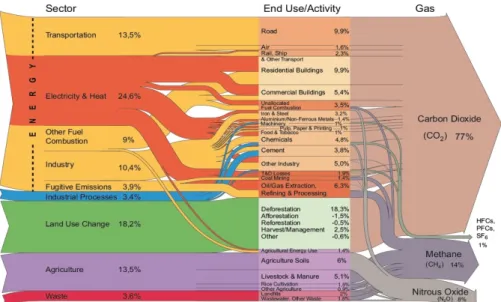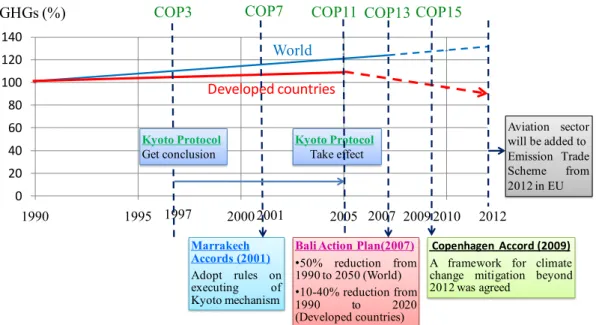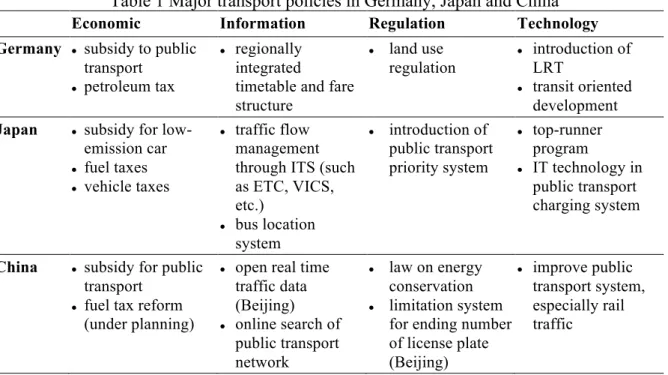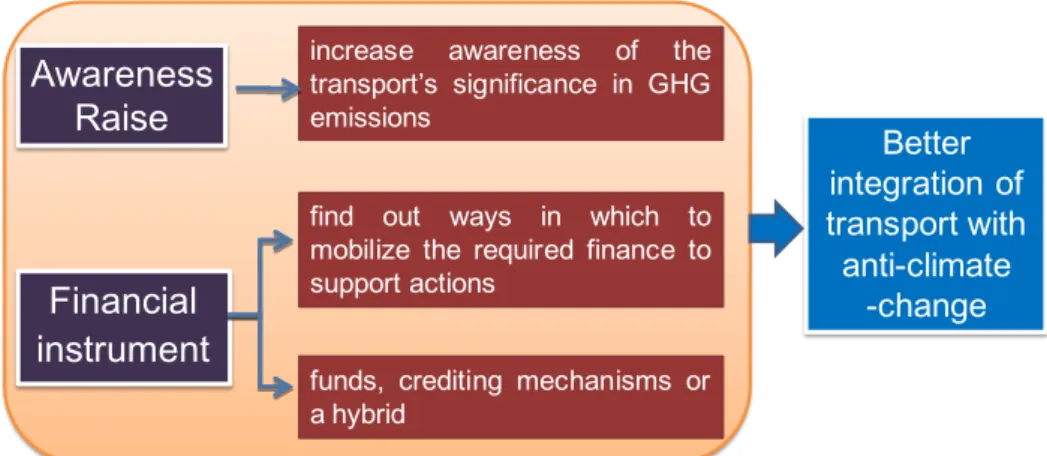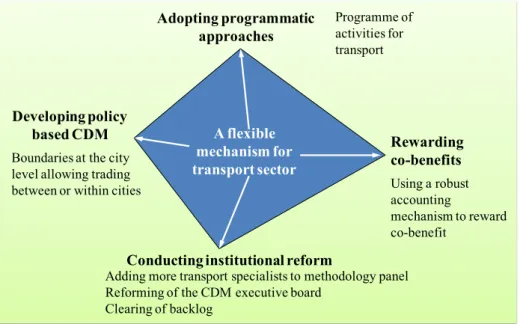Policy and Market-based Mechanism toward a Green and Sustainable
Transport
Ji HAN
Assistant Professor
Graduate School of Environmental Studies Nagoya University
Furo-cho, Chikusa-ku, Nagoya, 464-8603 Japan Fax: +81-52-789-3840
E-mail: hanji_cn@hotmail.com
Abstract: In the worldwide scope after the Kyoto Protocol was signed, a variety of
negotiations, mechanisms and policies have been addressed to prevent from the climate change. In this paper, we categorize national transport policies of Germany, Japan and China from the viewpoint of economic, information, regulation and technology. Moreover we evaluate the development and insufficiencies of major international anti-climate-change negotiations and mechanisms in benefitting transport sector. As a result, we find that the selected developed and developing countries have been effectively implementing their own domestic policies guiding to a sustainable transport. However, methodological, financial and institutional barriers of existing mechanisms have hampered transport sector in abating climate change through international coordination. As a proposal for the future mechanism design, we suggest a flexible mechanism that is expected to be workable for transport through the development of policy based CDM, institutional reform, rewarding co-benefits and adoption of programmatic approaches.
Key Words: transport policy, market-based mechanism, climate change, sustainability
1. INTRODUCTION
Transportation is a major consumer of fossil fuel energy and a significant contributor to climate change. It is also one of the most difficult sources to control. As shown in figure 1, transport sector as a whole accounted for 13.5% of world global greenhouse gas (GHG) emissions in 2000. And the share amounted to 23% in 2004. Transport-related CO2 emissions are expected to increase 57% worldwide in 2030 comparing with the level of 2005. The largest share of GHG emissions from the transport sector are still expected to be from developed countries. But in developing countries, where globalization is expanding trade flows and rising income level is amplifying demand for motorized mobility, transport energy use is supposed to be increasing faster than that in developed nations, and projected to grow from 31% in 2002 to 45% of world total transport energy use in 2030. Accordingly, transport-related CO2 emissions from developing countries are poised to soar with the development of economy and motorization, and will be responsible for approximately 80% of the total predicted increase (International Panel on Climate Change 2007, IEA 2008, Bongardt et al. 2009).
In the world scope especially after the Kyoto Protocol was signed in 1997, a variety of negotiations and mechanisms have been developed to prevent from the climate change with focus on different sectors especially the manufacturing industry, such as Clean Development Mechanism (CDM), Emission Trade Scheme (ETS), and Joint Implementation (JI), etc.
However, these mechanisms may not be efficient for transport sector. Transport has not benefitted from the existing Kyoto Protocol instruments that are currently in place. For example, figure 2 shows the project number of CDM. By August of 2009, there are only 2 of total 1774 (0.03%) registered CDM projects are transport projects. While for energy and manufacturing industries, they took an as large share as 60% and 5.7% respectively
(UNFCCC, 2010a). Thus it calls for a more constructive role of transport in abating climate change from now on.
Figure 1 World GHG emissions by sector (2000)
Source: World Resources Institute, Climate Analysis Indicator Tool
Sectoral Scope Registered Projects
(01) Energy industries (renewable - / non-renewable sources) 1297 (02) Energy distribution 0 (03) Energy demand 23 (04) Manufacturing industries 101 (05) Chemical industries 59 (06) Construction 0 (07) Transport 2 (08) Mining/mineral production 22 (09) Metal production 6 (10) Fugitive emissions from fuels (solid, oil and gas) 130 (11) Fugitive emissions from production and consumption of halocarbons and sulphur hexafluoride
22
(12) Solvent use 0 (13) Waste handling and
disposal 377 (14) Afforestation and reforestation 6 (15) Agriculture 122 Transport 0.03% Energy Industry 59.85%
Figure 2 Distribution of registered CDM projects by sectoral scope
Revised based on the data from http://cdm.unfccc.int/ As a proposal for the right way of transport sector towards a green and sustainable future, in this paper, we firstly investigate the developing process of existing anti-climate-change negotiations in the world. Secondly, we look insight at national transport policies and market-based mechanisms for mitigating climate change in several developed and developing countries such as Germany, Japan and China. Thirdly, through the evaluation of existing
instrument’s advantages and insufficiencies, we propose a conceptual framework to illustrate how greenhouse gas emission mitigation can be effectively implemented in transport sector.
2. ANTI-CLIMMATE-CHANGE NEGOTIATION
In 1992, the United Nations Framework Convention on Climate Change (UNFCCC) was founded at the United Nations conference on environment and development. Its ultimate goal is to stabilize greenhouse gas concentrations in the atmosphere at a level that would prevent dangerous human interference with the climate system. Figure 3 shows the change of GHGs and the development of major international agreements for tackling climate change under the UNFCCC framework.
First, the 3rd conference of the parties (COP) concluded with the Kyoto Protocol in 1997, which is recognized as the most initiative agreement and an important complement to the convention. It set binding targets for 37 industrialized countries and the European Commission for reducing GHG emissions. These binding targets amount to an average of 5% against 1990 levels over the five-year period 2008-2012. The Protocol points out that industrialized countries must first and foremost take domestic actions against climate change. But it also allows them to meet their emission reduction commitments abroad through so-called “market-based mechanisms”.
Second, COP7 meeting took place in 2001 and reached so called “Marrakech Accords”, which adopted most of the operational rules and set the stage for developed nations to ratify the Kyoto Protocol.
Third, COP11, held in 2005, was also the first Meeting of the Parties (MOP) to the Kyoto Protocol since their initial meeting in 1997. It marked the entry into force of the Kyoto Protocol, and hammered out to extend the life of the Kyoto Protocol beyond its 2012 expiration date and to negotiate deeper cuts in GHGs emission.
Fourth, COP13 concluded with the Bali Action Plan in 2007 and adopted an agreement on the action of long-term cooperation and structured negotiation on the post-Kyoto Protocol framework. It brought out the nationally appropriate mitigation actions for developing countries in the context of sustainable development, which must be supported and enabled by technology, financing and capacity-building in a measurable, reportable and verifiable manner.
Fifth, COP15 took place in 2009 however did not achieve a binding agreement for long-term action. “Copenhagen Accord' was negotiated by approximately 25 parties including USA and China, but it was only noted by the COP as an external document, not negotiated within the UNFCCC process.It marked the end of a crucial year for climate negotiations.
These agreements, accords and negotiations stated above have initiated the domestic action and international cooperation on tackling climate change. However, they focused on general instruments and targets rather than tailoring explicit approaches for specific sector. As a result, transport could very limitedly benefit from them. Though the planning on transport sector is now moving ahead, for example, aviation sector which is now excluded from Kyoto Protocol will be added to emissions trading scheme from 2012 in EU. The share of air transport GHG emissions is only 13% of total, the improvement on the land transport is more
important. It is vital that the transport sector takes a proactive approach to ensure that sustainable transport is recognized in the climate change negotiations, and that the post 2012 agreement works for transport.
0 20 40 60 80 100 120 140 1990 1995 2000 2005 2010 Developed countries 1997
GHGs (%) COP3 COP7 COP13
World Marrakech Accords (2001) Adopt rules on executing of Kyoto mechanism
Bali Action Plan(2007)
•50% reduction from 1990 to 2050 (World) •10-40% reduction from 1990 to 2020 (Developed countries) Aviation sector will be added to Emission Trade Scheme from 2012 in EU 2012 2007 2001 COP15 2009 Copenhagen Accord (2009)
A framework for climate change mitigation beyond 2012 was agreed Kyoto Protocol Take effect Kyoto Protocol Get conclusion COP11
Figure 3 Development of anti-climate-change negotiations since the 1990s
3. NATIONAL TRANSPORT POLICY AND MARKET-BASED MECHANISMS
Developed countries with commitment under the Kyoto Protocol and developing countries though having no mitigation obligation yet may limit or reduce their fossil fuel consumption and GHG emissions primarily either through domestic measures or by market-based mechanisms. In this section, we take Germany, Japan and China as examples and summarize their major national transport policies from the viewpoint of economic, information, regulation and technology (Table 1). Moreover, we analyze the barriers of existing mechanisms so that modifications and improvements could be made in the future mechanism designing.
3.1 National Transport Policy
Generally, Japan focuses on the information and technology innovation. China tries to improve its public transport system and energy conservation. Germany makes great efforts on public transport system. Specifically, Japan government has laid great emphases on the improvement of road traffic because it contributed to about 80% of total transport CO2 emissions in 2007 (International Transport Forum, 2010). To enhance the vehicle fuel efficiency and to raise the average traffic speed have been considered as two important premises, and supported by a variety of information and technological innovations. In 1998, Top-runner Program was initiated to improve energy efficiency of home/office appliances and passenger automobiles. It takes into account technological potential and set standards based on various parameters, which enable producer flexibility to provide a wide range of product models to meet the market need while at the same time guiding the overall market towards higher energy efficiency. Moreover, ITS (Intelligent Transport System), as an integration of several specifically developed systems such as car navigation system, VICS (Vehicle Information and Communication System), ETC (Electronic Toll Collection), etc., has also
been promoted to smooth traffic flow since the 1990s.
In China, energy conservation in transportation sector is especially emphasized as an independent chapter in the Law on Energy Conservation since 1998. Since the 1990s, more and more intensive transport policies have been implemented in China with the general targets aiming at encouraging the development of light vehicles and public transport, and improving the fuel economy. Recently the Eleventh Five-Year Plan for China’s transport sector goes further and stresses that GHG emission should be controlled.
In EU, Germany is known as one the prime examples for promoting public transport through regionally integrated timetables and fare structures, high level of service with modern, attractive rolling stock. On the other hand, German government has been trying to depress the attractiveness of automobile use through imposing very high taxes on gasoline. In 2008 the USA gasoline taxes constitute 15% of the selling price compared to 60% in Germany. Besides, steeply discounted region-wide monthly and annual public transport tickets also make public transport financially more attractive for passengers.
Table 1 Major transport policies in Germany, Japan and China Economic Information Regulation Technology Germany subsidy to public
transport
petroleum tax
regionally
integrated
timetable and fare structure land use regulation introduction of LRT transit oriented development
Japan subsidy for
low-emission car
fuel taxes vehicle taxes
traffic flow
management through ITS (such as ETC, VICS, etc.) bus location system introduction of public transport priority system top-runner program IT technology in public transport charging system
China subsidy for public
transport
fuel tax reform
(under planning)
open real time
traffic data (Beijing) online search of public transport network law on energy conservation limitation system
for ending number of license plate (Beijing) improve public transport system, especially rail traffic 3.2 Market-based Mechanisms
As additional means to national transport policies, Kyoto Protocol introduced three market-based mechanisms for carbon market, which are known as ETS, CDM and JI.
Emissions Trading Scheme allows countries that have spare emission units - emissions quota permitted but not "used" - to sell the excess capacity to countries that have exceeded their permitted targets.
Clean Development Mechanism allows a country with an emission-reduction or limitation commitment under the Kyoto Protocol to implement an emission-reduction project in developing countries. Such projects can earn saleable certified emission reduction credits, each equivalent to one ton of CO2, which can be counted to meeting Kyoto targets.
Joint Implementation allows an Annex B Party with an emission reduction commitment under the Kyoto Protocol to earn emission reduction units through GHG reduction or
removal projects in another Annex B Party.
However, the above three Kyoto mechanisms have not succeeded in promoting sustainable transport. As said in the introduction, the registered transport CDM projects are extremely less comparing with other sectors. It could be attributed to a number of barriers such as 1) methodological reason, notably the difficulty in proving baselines and boundaries and the lack of recognition of co-benefits; 2) financial barrier, which includes high transaction costs, monitoring costs and abatement costs, as well as the low carbon price for transport for investors; 3) institutional constraint that transport experts are not adequately represented on the CDM methodology panel.
Similarly, when looking at JI mechanism, there is no transport projects have ever been registered under JI (UNFCCC, 2010b), which causes a widespread doubt on the feasibility of applying JI mechanism to transportation. The failure may largely due to the following reasons like 1) competition with CDM projects. Though the track 1 procedure of JI mechanism is considered more flexible than the CDM projects, CDM is still preferred by parties than other options; 2) low awareness of industrial sectors and countries. Some sectors are more interested in asking for subsidies than in participating in market mechanisms. Many host countries neither know that they can implement JI projects in their own countries, nor do they know that sectoral JI has existed under track 2 procedure since 2008.
Therefore, if countries are to achieve green and sustainable transport, it is necessary for the existing mechanisms to be significantly modified, or for new mechanisms to be introduced.
4. PROPOSAL OF A FLEXIABLE MECHANISM
On the basis of the evaluation of existing mechanisms’ insufficiencies, we propose a conceptual mechanism to illustrate how greenhouse gas emission mitigation can be effectively implemented in the transport sector.
Awareness Raise
Financial instrument
increase awareness of the transport s significance in GHG emissions
find out ways in which to mobilize the required finance to support actions
funds, crediting mechanisms or a hybrid Better integration of transport with anti-climate -change
Figure 4 Prerequisites for integration of transport with climate change
First, two prerequisites for better integration of transport with climate change should be recognized (figure 4). One is to increase awareness of the transport’s significance in GHG emissions. The other is to find out ways in which to mobilize the required finance to support actions. Funds, crediting mechanisms or a hybrid of these two should be considered.
transport sector. Improvements could be made in the following four aspects (figure 5).
1) To develop policy based CDM. It may have boundaries at city level and allow trading between or within cities.
2) To conduct institutional reform. Options like adding more transport specialists into methodology panel, reforming the existing CDM executive board, and clearing of backlog would be effective for the improvement of said constraints of CDM.
3) To reward co-benefits. Adoption of a robust accounting system to reward co-benefit may avoid double-counting and allow comparability with other sectors. The detailed ways may include the development of verification methods that are appropriate for both regulated and voluntary sectors, and the approval of projects that can definitely realize co-benefits. 4) To adopt programmatic approaches. Program of activities, which is firstly addressed at
COP11 as measures implemented voluntarily by entities to reduce real GHG emissions, could be developed to suit for transport sector.
Adopting programmatic approaches
Developing policy
based CDM Rewarding
co-benefits
Conducting institutional reform
A flexible mechanism for transport sector Boundaries at the city
level allowing trading between or within cities
Programme of activities for transport
Adding more transport specialists to methodology panel Reforming of the CDM executive board
Clearing of backlog
Using a robust accounting
mechanism to reward co-benefit
Figure 5 A flexible mechanism for transport sector
5. CONCLUSION
Due to the important role in the context of climate change, mitigation of non-renewable energy use and GHG emissions in transport sector have been paid wide attentions especially in the recent years and near future. This paper tries to investigate the development of existing anti-climate-change negotiations under UNFCCC, and categorize national transport policies of Germany, Japan and China from the aspects of economic, information, regulation and technology. Moreover we evaluate the deficiencies of existing market-based mechanisms so that a flexible mechanism is proposed for transport sector in terms of anti-climate-change. It is found that both developed and developing countries have been implementing their own domestic policies guiding transport towards a low carbon one. More specifically, Germany makes great efforts in enhancing the attractiveness of public transport. Japan endeavors to improve road transport through information and technological innovations. China focuses on energy conservation and promotion of public transport system. While for international co-ordinations in abating climate change, although a number of negotiations and market-based mechanisms have been brought into forth since the 1990s, transport sector has seldom got real
benefits. The reasons may due to the several constraints such as methodological insufficiency in proving boundaries and recognizing co-benefits, financial barrier and institutional deficiency. Accordingly, on the recognition of two important prerequisites like raising the awareness of transport role in anti-climate-change framework, and mobilizing the required finance to support actions, in the future negotiations especially concerning transport sector, a flexible mechanism is expected to be workable through development of policy based CDM, institutional reform, rewarding co-benefits and adoption of programmatic approaches.
REFERENCES
Bongardt, D., Rudolph, F., Sterk, W. (2009) Transport in developing countries and climate policy: suggestions for a Copenhagen agreement and beyond. Wuppertal Institute for Climate Environment and Energy.
International Panel on Climate Change. (2007) IPCC Fourth Assessment Report, Working Group III Report "Mitigation of Climate Change". Available on http://www.ipcc.ch/. IEA (2008) World Energy Outlook 2008. Available on http://www.iea.org/weo/2008.asp. International Transport Forum. (2010) Key Transport and Greenhouse Gas Indicators: Inform
ation by Country. Available on http://www.internationaltransportforum.org/statistics/CO2/ index.html
United Nations Framework Convention on Climate Change. (2010a) CDM statistics. Available on http://cdm.unfccc.int/Statistics/index.html.
United Nations Framework Convention on Climate Change. (2010b) JI projects. Available on http://ji.unfccc.int/JI_Projects/index.html.
World Resources Institute, Climate Analysis Indicator Tool. (2010) World GHG emissions flow chart. Available on http://cait.wri.org/figures.php?page=/World-FlowChart.
